The National Flood Insurance Program (NFIP) needs to change. It was
$30 billion in debt last year (though Congress forgave $16 billion of that), its flood maps are woefully outdated and its incentives are out of whack – while the riskiest homes it insures make up just 2% of premiums, they account for
25% of claims.
In recent months, Congress has extended the program (and occasionally let it lapse) without making any meaningful reforms – a strategy that has proven woefully inadequate to the problems the NFIP faces. This month presents yet another deadline: Unless Congress renews the NFIP by tomorrow, it will lapse. This is a golden opportunity to modernize a program that is not adequate for the new realities of severe weather.
We’ve faced this opportunity before, and various stakeholders have offered solutions. One
common chorus is to encourage private insurers to get in the game to fix the NFIP. I’d like to modify that proposal slightly: Privatize flood insurance, and make everyone get it.
If this sounds philosophically similar to what the Affordable Care Act tried to do for health insurance, that’s because it is. We all agree that health insurance premiums won’t come down if only sick people buy it. Encouraging everyone to buy health insurance makes sense because everyone – even the healthiest among us – faces risk. Anyone, after all, can get hit by a bus.
Today, the same is true of flooding. After last year’s hurricane season, FEMA’s official position became “
anywhere it can rain, it can flood.” In other words: All of us could benefit from flood insurance.
See also: Emerging Market for Flood Insurance
Of course, there are several major differences between the health and flood insurance landscapes.
First, while nutrition and medical research are improving our tools for staying healthy, our collective flood exposure is growing. There are three major culprits:
- Human nature. We like living near water, which means living in high-risk areas. As long as people will buy or rent homes near the water, developers will build them.
- The current regulatory environment provides incentives for development without providing incentives for management of flood risks – we saw the results of this all too clearly when Harvey hit Houston last year, and we saw it again this hurricane season with Florence and Michael.
- Extreme weather is the new normal. Four of the five most damaging (and expensive) hurricanes of all time have happened since 2012. The most expensive was in 2005. This is not a fluke.
The second important difference between flood insurance and health insurance is that the American people are already paying for flood insurance. The NFIP is a taxpayer-subsidized program, but only taxpayers with an active policy enjoy protection in the event of a flood. Privatized universal coverage would not greatly affect the number of people currently paying for flood insurance, but it would significantly increase the number of people who enjoy the benefits of coverage because payments would be tied to actual policies.
The third difference is that our current system for flood insurance encourages behavior by homeowners, developers and local leaders that works against everyone’s long-term interest. For example, the NFIP currently has updated flood maps for some communities that show an increased number of homes at risk for floods. But residents have, in some cases, successfully lobbied for delays in the effective date of those maps because, as soon as they become effective, home values will drop and residents will have to start buying flood insurance.
In other words, skewed incentives are pushing people to act against their best financial interest and against the interests of other taxpayers. Privately run flood insurers would mean no reelection pressures to falsify flood maps (which local politicians currently face), and homeowners for whom flood insurance is mandatory would have no incentive to avoid it.
See also: Future of Flood Insurance
Beyond all this, though, privatization makes sense for other reasons. Private insurers would find ways to provide incentives for relocation rather than rebuilding in areas that flood repeatedly. They would prioritize the data analysis necessary to make flood maps that are both accurate and predictive. And they would likely lend their lobbying weight to reforming development and environmental regulations that contribute to our growing flood exposure.
This amounts to a significant change in how we think about flood insurance in the U.S., but our risk of flooding has changed significantly in recent years. Anything short of a drastic overhaul will mean the NFIP just ends up further underwater.






